low oil pressure MITSUBISHI OUTLANDER 2019 Owner's Manual (in English)
[x] Cancel search | Manufacturer: MITSUBISHI, Model Year: 2019, Model line: OUTLANDER, Model: MITSUBISHI OUTLANDER 2019Pages: 451, PDF Size: 58.02 MB
Page 172 of 451
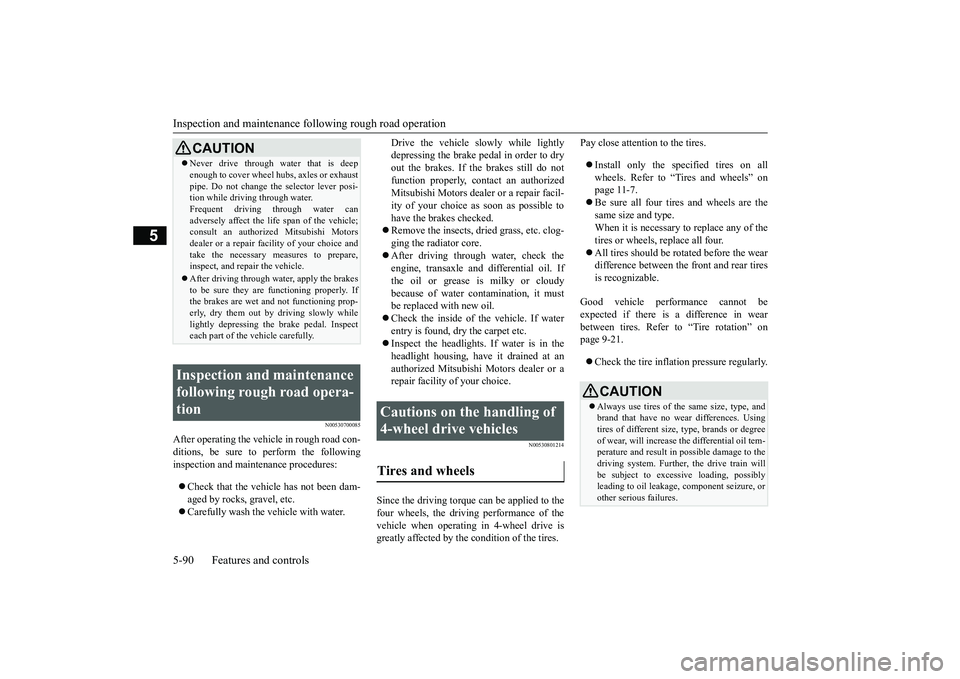
Inspection and maintenance following rough road operation 5-90 Features and controls
5
N00530700085
After operating the vehicle in rough road con- ditions, be sure to perform the followinginspection and maintenance procedures: Check that the vehicle has not been dam- aged by rocks, gravel, etc. Carefully wash the vehicle with water.
Drive the vehicle sl
owly while lightly
depressing the brake pedal in order to dryout the brakes. If the brakes still do not function properly, contact an authorized Mitsubishi Motors dealer or a repair facil-ity of your choice as soon as possible to have the brakes checked. Remove the insects, dr
ied grass, etc. clog-
ging the radiator core. After driving through water, check the engine, transaxle and differential oil. If the oil or grease is milky or cloudy because of water cont
amination, it must
be replaced with new oil. Check the inside of the vehicle. If water entry is found, dry the carpet etc. Inspect the headlights. If water is in the headlight housing, have it drained at an authorized Mitsubishi
Motors dealer or a
repair facility of your choice.
N00530801214
Since the driving torque can be applied to thefour wheels, the driving performance of the vehicle when operating in 4-wheel drive is greatly affected by the
condition of the tires.
Pay close attenti
on to the tires.
Install only the specified tires on all wheels. Refer to “Tires and wheels” onpage 11-7. Be sure all four tires and wheels are the same size and type.When it is necessary to replace any of the tires or wheels, replace all four. All tires should be ro
tated before the wear
difference between the front and rear tires is recognizable.
Good vehicle performance cannot be expected if there is a difference in wear between tires. Refer to “Tire rotation” on page 9-21. Check the tire inflation pressure regularly.
CAUTIONNever drive through water that is deep enough to cover wheel hubs, axles or exhaustpipe. Do not change th
e selector lever posi-
tion while driving through water. Frequent driving through water can adversely affect the life
span of the vehicle;
consult an authorized Mitsubishi Motors dealer or a repair faci
lity of your choice and
take the necessary measures to prepare,inspect, and repair the vehicle. After driving through water, apply the brakes to be sure they are
functioning properly. If
the brakes are wet and not functioning prop- erly, dry them out by driving slowly whilelightly depressing the brake pedal. Inspect each part of the vehicle carefully.
Inspection and maintenance following rough road opera-tion
Cautions on the handling of 4-wheel drive vehicles Tires and wheels
CAUTION Always use tires of th
e same size, type, and
brand that have no wear differences. Using tires of different size,
type, brands or degree
of wear, will increase the differential oil tem- perature and result in possible damage to the driving system. Further, the drive train willbe subject to excessi
ve loading, possibly
leading to oil leakage,
component seizure, or
other serious failures.
BK0264300US.book 90 ページ 2018年2月28日 水曜日 午後5時16分
Page 285 of 451
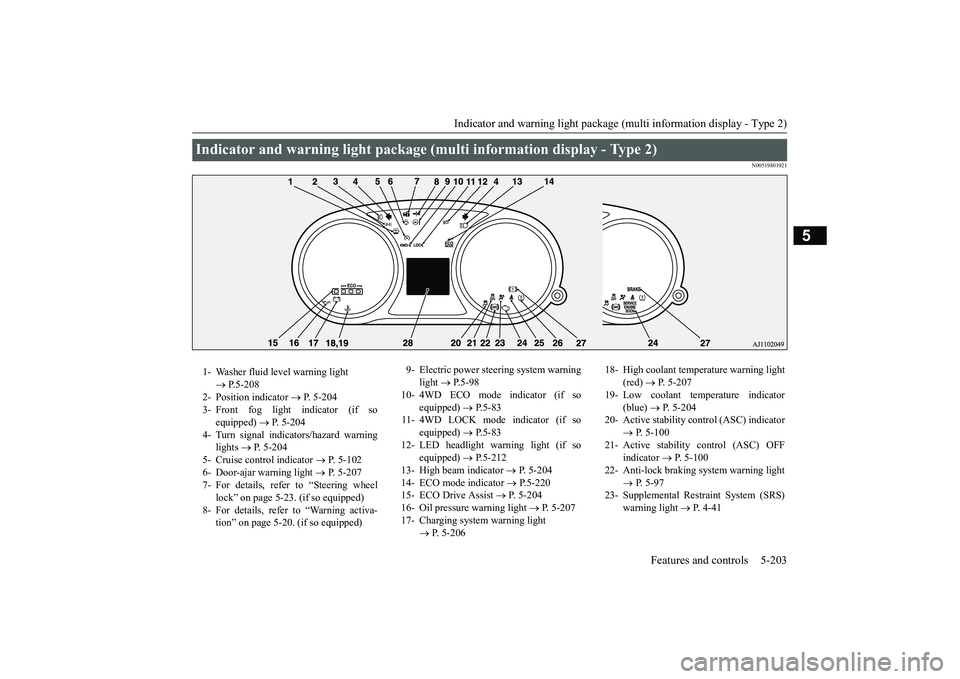
Indicator and warning light package (multi information display - Type 2)
Features and controls 5-203
5
N00519801921
Indicator and warning light package (mu
lti information display - Type 2)
1- Washer fluid level warning light
P.5-208
2- Position indicator
P. 5-204
3- Front fog light indicator (if so
equipped)
P. 5-204
4- Turn signal indicators/hazard warning
lights
P. 5-204
5- Cruise control indicator
P. 5-102
6- Door-ajar warning light
P. 5-207
7- For details, refer to “Steering wheel
lock” on page 5-23. (if so equipped)
8- For details, refer to “Warning activa-
tion” on page 5-20. (if so equipped)
9- Electric power steering system warning
light
P.5-98
10- 4WD ECO mode indicator (if so
equipped)
P.5-83
11- 4WD LOCK mode indicator (if so
equipped)
P.5-83
12- LED headlight warning light (if so
equipped)
P.5-212
13- High beam indicator
P. 5-204
14- ECO mode indicator
P.5-220
15- ECO Drive Assist
P. 5-204
16- Oil pressure warning light
P. 5-207
17- Charging system warning light
P. 5-206
18- High coolant temperature warning light
(red)
P. 5-207
19- Low coolant temp
erature indicator
(blue)
P. 5-204
20- Active stability control (ASC) indicator
P. 5-100
21- Active stability control (ASC) OFF
indicator
P. 5-100
22- Anti-lock braking system warning light
P. 5-97
23- Supplemental Restra
int System (SRS)
warning light
P. 4 - 4 1
BK0264300US.book 203 ページ 2018年2月28日 水曜日 午後5時16分
Page 289 of 451
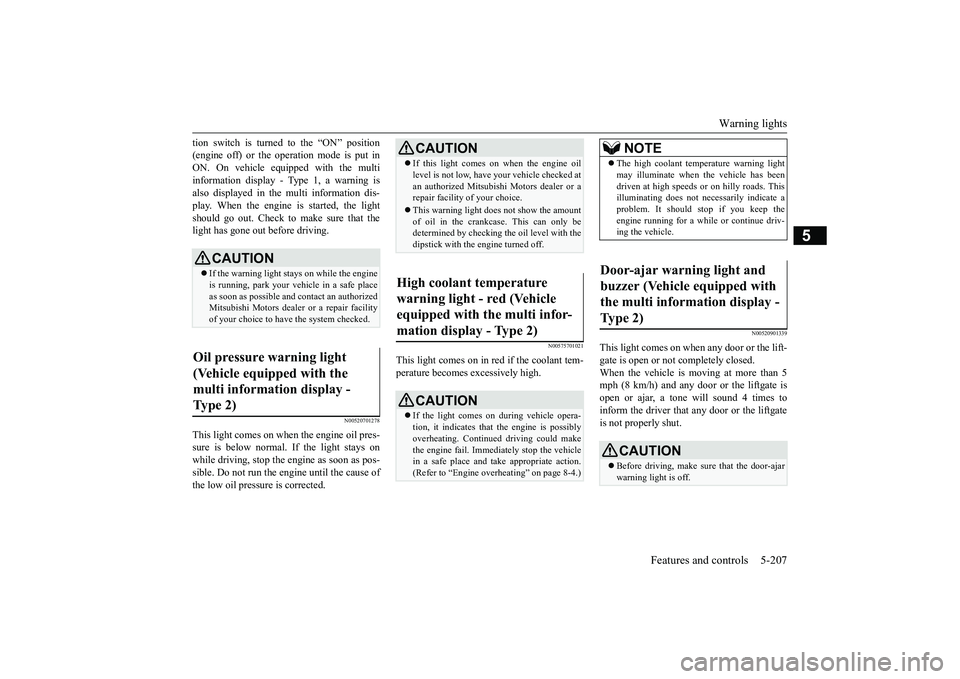
Warning lights
Features and controls 5-207
5
tion switch is turned to the “ON” position (engine off) or the operation mode is put inON. On vehicle equipped with the multi information display - Type 1, a warning is also displayed in the multi information dis-play. When the engine is started, the light should go out. Check to make sure that the light has gone out before driving.
N00520701278
This light comes on when the engine oil pres-sure is below normal. If the light stays on while driving, stop the engine as soon as pos- sible. Do not run the engine until the cause ofthe low oil pressure is corrected.
N00575701021
This light comes on in red if the coolant tem- perature becomes excessively high.
N00520901339
This light comes on when any door or the lift- gate is open or not completely closed. When the vehicle is moving at more than 5 mph (8 km/h) and any door or the liftgate isopen or ajar, a tone will sound 4 times to inform the driver that any door or the liftgate is not properly shut.
CAUTION If the warning light stays on while the engine is running, park your ve
hicle in a safe place
as soon as possible and
contact an authorized
Mitsubishi Motors dealer
or a repair facility
of your choice to have the system checked.
Oil pressure warning light (Vehicle equipped with the multi information display - Type 2)
CAUTION If this light comes on when the engine oil level is not low, have
your vehicle checked at
an authorized Mitsubish
i Motors dealer or a
repair facility
of your choice.
This warning light does not show the amount of oil in the crankcase. This can only be determined by checking the oil level with the dipstick with the engine turned off.
High coolant temperature warning light - red (Vehicle equipped with the multi infor- mation display - Type 2)
CAUTION If the light comes on
during vehicle opera-
tion, it indicates that
the engine is possibly
overheating. Continue
d driving could make
the engine fail. Immedi
ately stop the vehicle
in a safe place and ta
ke appropriate action.
(Refer to “Engine overh
eating” on page 8-4.)
NOTE
The high coolant temp
erature warning light
may illuminate when
the vehicle has been
driven at high speeds or on hilly roads. Thisilluminating does not ne
cessarily indicate a
problem. It should stop if you keep the engine running for a whil
e or continue driv-
ing the vehicle.
Door-ajar warning light and buzzer (Vehicle equipped with the multi information display - Type 2)
CAUTION Before driving, make sure that the door-ajar warning light is off.
BK0264300US.book 207 ページ 2018年2月28日 水曜日 午後5時16分
Page 291 of 451
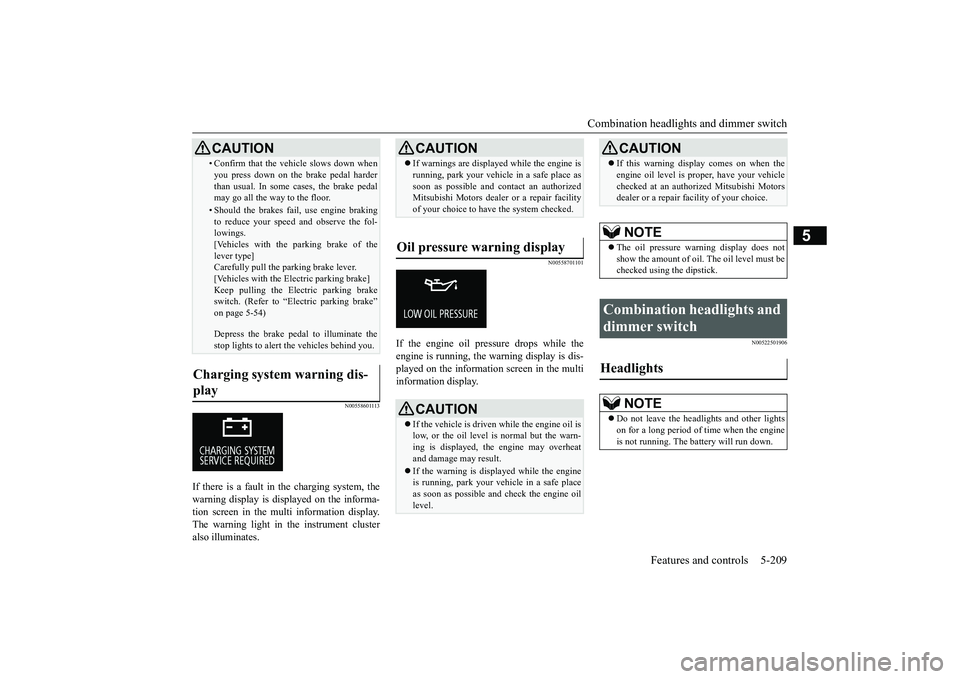
Combination headlights and dimmer switch
Features and controls 5-209
5
N00558601113
If there is a fault in the charging system, the warning display is di
splayed on the informa-
tion screen in the multi information display.The warning light in the instrument cluster also illuminates.
N00558701101
If the engine oil pressure drops while the engine is running, the
warning display is dis-
played on the information screen in the multi information display.
N00522501906
• Confirm that the vehicle slows down when you press down on the brake pedal harderthan usual. In some cases, the brake pedalmay go all the way to the floor.• Should the brakes fail, use engine brakingto reduce your speed and observe the fol- lowings. [Vehicles with the parking brake of thelever type] Carefully pull the pa
rking brake lever.
[Vehicles with the Electric parking brake]Keep pulling the Elec
tric parking brake
switch. (Refer to “Electric parking brake” on page 5-54) Depress the brake pedal to illuminate the stop lights to alert th
e vehicles behind you.
Charging system warning dis- play
CAUTION
CAUTION If warnings are displaye
d while the engine is
running, park your vehicl
e in a safe place as
soon as possible and contact an authorizedMitsubishi Motors dealer
or a repair facility
of your choice to have the system checked.
Oil pressure warning display
CAUTION If the vehicle is driven while the engine oil is low, or the oil level is normal but the warn-ing is displayed, th
e engine may overheat
and damage may result. If the warning is displayed while the engine is running, park your ve
hicle in a safe place
as soon as possible and check the engine oil level.
If this warning display comes on when the engine oil level is prope
r, have your vehicle
checked at an author
ized Mitsubishi Motors
dealer or a repair fa
cility of your choice.
NOTE
The oil pressure warning display does not show the amount of oil. The oil level must be checked using the dipstick.
Combination headlights and dimmer switch Headlights
NOTE
Do not leave the head
lights and ot
her lights
on for a long period of time when the engine is not running. The battery will run down.CAUTION
BK0264300US.book 209 ページ 2018年2月28日 水曜日 午後5時16分
Page 336 of 451
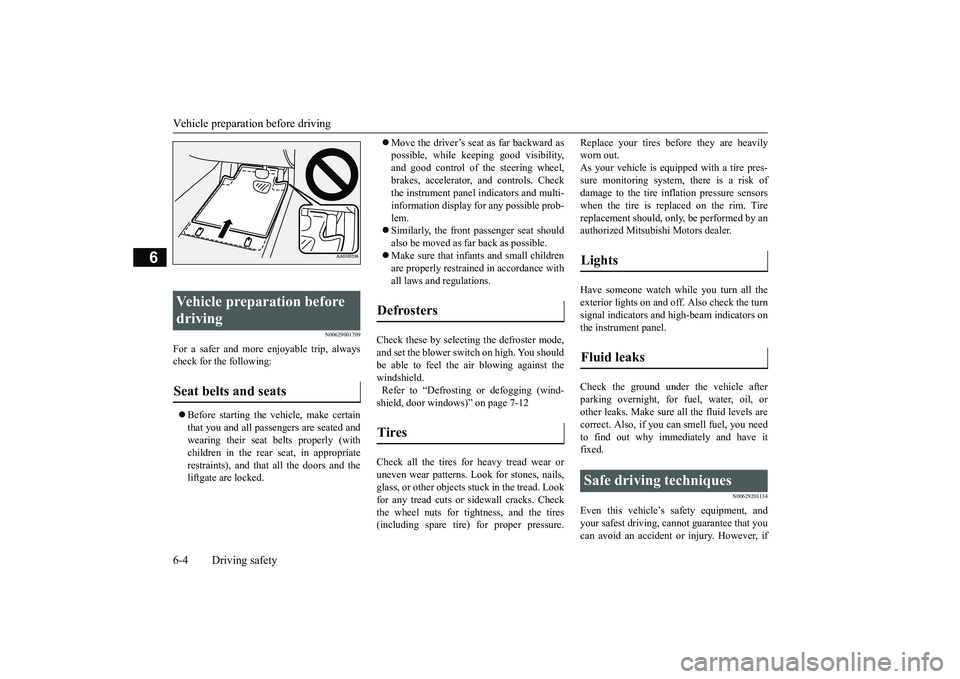
Vehicle preparation before driving 6-4 Driving safety
6
N00629001709
For a safer and more enjoyable trip, always check for the following: Before starting the vehicle, make certain that you and all passengers are seated andwearing their seat
belts properly (with
children in the rear seat, in appropriate restraints), and that all the doors and theliftgate are locked.
Move the driver’s seat as far backward as possible, while keeping good visibility,and good control of the steering wheel, brakes, accelerator, and controls. Check the instrument panel indicators and multi-information display
for any possible prob-
lem. Similarly, the front
passenger seat should
also be moved as fa
r back as possible.
Make sure that infants and small children are properly restrained in accordance with all laws and
regulations.
Check these by selecting the defroster mode, and set the blower swit
ch on high. You should
be able to feel the air blowing against thewindshield. Refer to “Defrosti
ng or defogging (wind-
shield, door windows)” on page 7-12 Check all the tires for heavy tread wear or uneven wear patterns. Look for stones, nails,glass, or other objects
stuck in the tread. Look
for any tread cuts or
sidewall cracks. Check
the wheel nuts for tightness, and the tires(including spare tire) for proper pressure.
Replace your tires before they are heavily worn out.As your vehicle is equi
pped with a tire pres-
sure monitoring system, there is a risk of damage to the tire inflation pressure sensorswhen the tire is replaced on the rim. Tire replacement should, onl
y, be performed by an
authorized Mitsubishi Motors dealer. Have someone watch wh
ile you turn all the
exterior lights on and off. Also check the turn signal indicators and hi
gh-beam indicators on
the instrument panel. Check the ground under the vehicle after parking overnight, for
fuel, water, oil, or
other leaks. Make sure
all the fluid levels are
correct. Also, if you
can smell fuel, you need
to find out why imme
diately and have it
fixed.
N00629201134
Even this vehicle’s sa
fety equipment, and
your safest driving, ca
nnot guarantee that you
can avoid an accident or injury. However, if
Vehicle preparation before driving Seat belts and seats
Defrosters Tires
Lights Fluid leaks Safe driving techniques
BK0264300US.book 4 ページ 2018年2月28日 水曜日 午後5時16分
Page 380 of 451
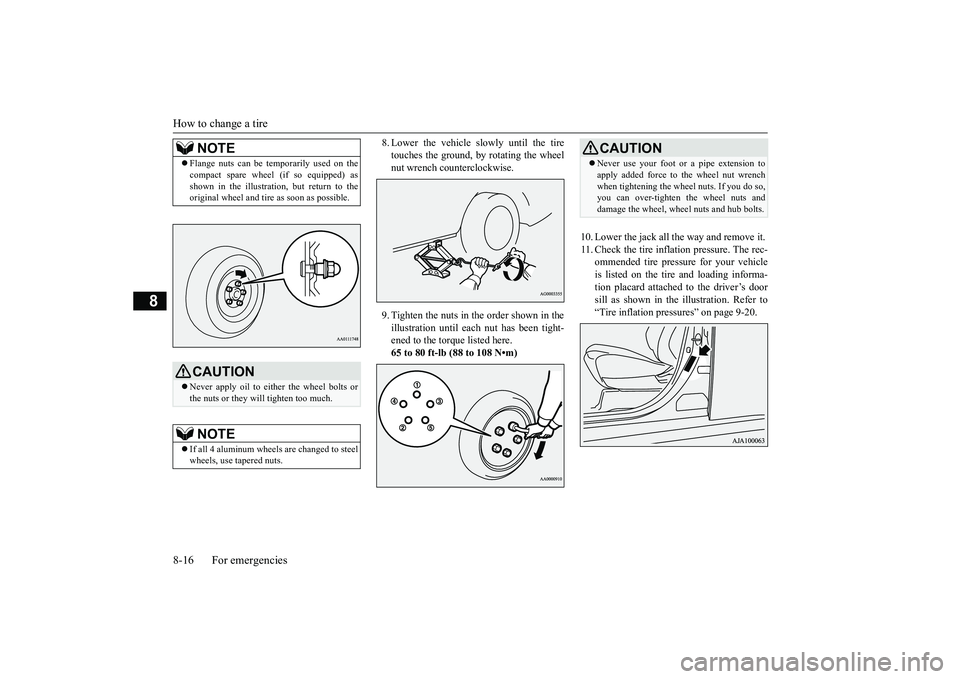
How to change a tire 8-16 For emergencies
8
8. Lower the vehicle slowly until the tire touches the ground, by rotating the wheelnut wrench counterclockwise. 9. Tighten the nuts in the order shown in the illustration until each
nut has been tight-
ened to the torque listed here.65 to 80 ft-lb (88 to 108 N•m)
10. Lower the jack all the way and remove it. 11. Check the tire inflation pressure. The rec-
ommended tire pressure for your vehicleis listed on the tire
and loading informa-
tion placard attached to the driver’s door sill as shown in the illustration. Refer to“Tire inflation pressures” on page 9-20.
NOTE
Flange nuts can be te
mporarily used on the
compact spare wheel (if so equipped) asshown in the illustration, but return to theoriginal wheel and tire as soon as possible.CAUTION Never apply oil to either the wheel bolts or the nuts or they will tighten too much.NOTE
If all 4 aluminum wheels are changed to steel wheels, use tapered nuts.
CAUTION Never use your foot or a pipe extension to apply added force to the wheel nut wrenchwhen tightening the wheel nuts. If you do so,you can over-tighten the wheel nuts and damage the wheel, wheel nuts and hub bolts.
BK0264300US.book 16 ページ 2018年2月28日 水曜日 午後5時16分
Page 391 of 451
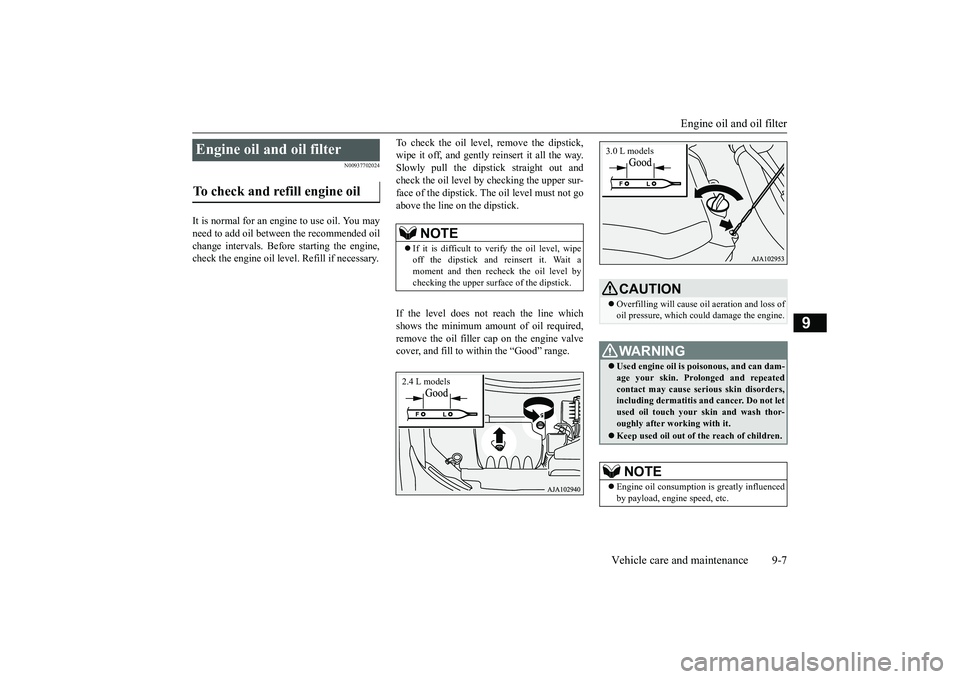
Engine oil and oil filter
Vehicle care and maintenance 9-7
9
N00937702024
It is normal for an engi
ne to use oil. You may
need to add oil betwee
n the recommended oil
change intervals. Before starting the engine,check the engine oil level. Refill if necessary.
To check the oil level,
remove the dipstick,
wipe it off, and gently reinsert it all the way.Slowly pull the dipsti
ck straight out and
check the oil level by checking the upper sur- face of the dipstick. The oil level must not goabove the line on the dipstick. If the level does not reach the line which shows the minimum am
ount of oil required,
remove the oil filler cap on the engine valve cover, and fill to within the “Good” range.
Engine oil and oil filter To check and refill engine oil
NOTE
If it is difficult to ve
rify the oil level, wipe
off the dipstick and
reinsert it. Wait a
moment and then recheck the oil level by checking the upper surface of the dipstick.2.4 L models
CAUTION Overfilling will cause
oil aeration and loss of
oil pressure, which coul
d damage the engine.
WA R N I N GUsed engine oil is poisonous, and can dam- age your skin. Prolonged and repeatedcontact may cause serious skin disorders, including dermatitis and cancer. Do not let used oil touch your skin and wash thor-oughly after working with it. Keep used oil out of
the reach of children.
NOTE
Engine oil consumption
is greatly influenced
by payload, engine speed, etc.3.0 L models
BK0264300US.book 7 ページ 2018年2月28日 水曜日 午後5時16分
Page 393 of 451
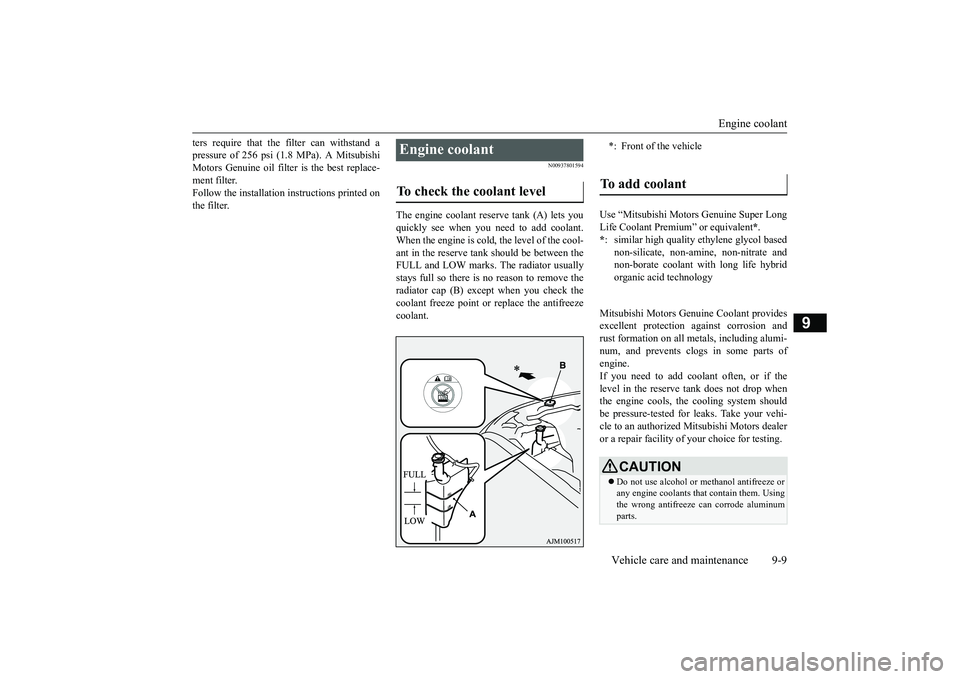
Engine coolant
Vehicle care and maintenance 9-9
9
ters require that the
filter can withstand a
pressure of 256 psi (1.8 MPa). A MitsubishiMotors Genuine oil filter is the best replace- ment filter. Follow the installation instructions printed onthe filter.
N00937801594
The engine coolant reserve tank (A) lets youquickly see when you need to add coolant. When the engine is cold
, the level of the cool-
ant in the reserve tank should be between theFULL and LOW marks. The radiator usually stays full so there is no reason to remove the radiator cap (B) except when you check the coolant freeze point or replace the antifreeze coolant.
Mitsubishi Motors Genuine Coolant provides excellent protection
against corrosion and
rust formation on all me
tals, including alumi-
num, and prevents cl
ogs in some parts of
engine.If you need to add coolant often, or if the level in the reserve
tank does not drop when
the engine cools, the
cooling system should
be pressure-tested for leaks. Take your vehi- cle to an authorized Mitsubishi Motors dealer or a repair facility of
your choice for testing.
Engine coolant To check the coolant level
*: Front of the vehicleTo add coolant Use “Mitsubishi Motors
Genuine Super Long
Life Coolant Premium” or equivalent
*.
* : similar high quality et
hylene glycol based
non-silicate, non-amine, non-nitrate and non-borate coolant with long life hybrid organic acid technologyCAUTION Do not use alcohol or
methanol antifreeze or
any engine coolants th
at contain them. Using
the wrong antifreeze can corrode aluminumparts.
BK0264300US.book 9 ページ 2018年2月28日 水曜日 午後5時16分
Page 405 of 451

Tires
Vehicle care and maintenance 9-21
9
N00939700141
The following maintenance steps are recom- mended: Check tire pressures regularly. Have regular maintenance done on the wheel balance and front
and rear suspen-
sion alignment. Rotate your tires regularly as described in the “Tire rotation” se
ction on page 9-21.
N00939800184
Tread wear indicators are built into the origi- nal equipment tires on your vehicle to help you know when your tires should be replaced.
Many states have la
ws requiring that you
replace your tires at this point.These indicators are molded into the bottom of the tread grooves and will appear when the tire tread is worn down to 1/16 inch (1.6mm). When the bands appear next to one another in two or more places
, replace your tires.
N00939901528
To even out the wear on your tires and make them last longer, Mitsubishi Motors Corpora-tion recommends that you rotate your tires at the mileage listed in the “WARRANTY AND MAINTENANCE MANUAL”.However, the timing for tire rotation may vary according to your vehicle condition, road surface conditions, and your own per-sonal driving habits. Any time you notice unusual wear, rotate your
tires as soon as pos-
sible. When rotating tires, check for uneven wear, damage, and wheel al
ignment. Abnormal
wear is usually caused by a wrong tire pres-
On all-wheel drive vehi
cles, always use tires
of the same size, same
type, and same brand,
and which have no wear differences. Usingtires that differ in si
ze, type, brand or the
degree of wear, will increase the differential oil temperature, resulting in possible damageto the driving system. Further, the drive train will be subjected to ex
cessive loading, possi-
bly leading to oil leakage, component sei-zure, or other serious problems. Only Mitsubishi Motors Authorized wheels should be used, beca
use your vehicle is
equipped with a tire pr
essure monitoring sys-
tem.Use of another type of wheel risks air leaks and sensor damage, as it
will not be possible
to install the tire pressure sensor properly.NOTE
On vehicles with Elec
tric parking brake, 16
inches steel wheel cannot be used on yourvehicle because it interferes with brake parts. Additionally, 16 inches aluminum wheel may not be used on
your vehicle depending
on its type, even if a Mitsubishi Motors Gen-uine wheels. Consult an authoriz
ed Mitsubishi Motors
dealer before using wh
eels that you have.
CAUTION
Tire maintenance Tread wear indicator 1- Location of the tread wear indicator 2- Tread wear indicator
NOTE
Tire wear indicators ca
n have different marks
and locations dependi
ng on the tire manufac-
turer.
Tire rotation
BK0264300US.book 21 ページ 2018年2月28日 水曜日 午後5時16分
Page 427 of 451
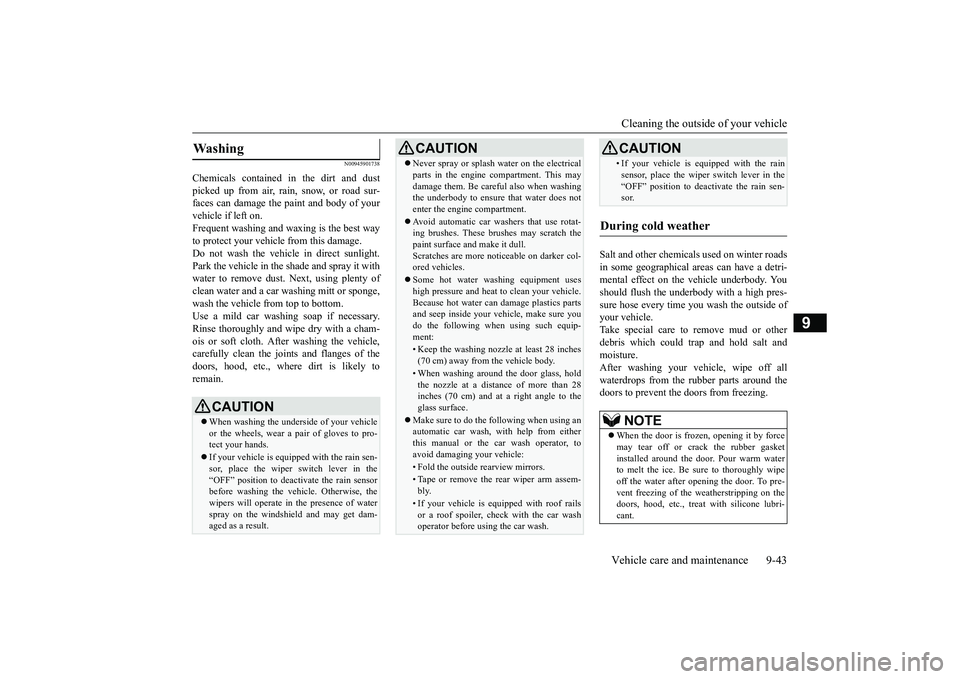
Cleaning the outside of your vehicle Vehicle care and maintenance 9-43
9
N00945901738
Chemicals contained in the dirt and dust picked up from air, rain, snow, or road sur- faces can damage the paint and body of yourvehicle if left on. Frequent washing and wa
xing is the best way
to protect your vehicle from this damage.Do not wash the vehicl
e in direct sunlight.
Park the vehicle in the shade and spray it with water to remove dust.
Next, using plenty of
clean water and a car washing mitt or sponge, wash the vehicle from top to bottom.Use a mild car washing soap if necessary. Rinse thoroughly and wipe
dry with a cham-
ois or soft cloth. Af
ter washing the vehicle,
carefully clean the join
ts and flanges of the
doors, hood, etc., wher
e dirt is likely to
remain.
Salt and other chemicals used on winter roads in some geographical areas can have a detri-mental effect on the vehicle underbody. You should flush the underb
ody with a high pres-
sure hose every time you wash the outside ofyour vehicle. Take special care to remove mud or other debris which could trap and hold salt andmoisture. After washing your vehicle, wipe off all waterdrops from the rubber parts around thedoors to prevent the doors from freezing.
Wa s h i n g
CAUTION When washing the underside of your vehicle or the wheels, wear a pair of gloves to pro- tect your hands. If your vehicle is equipped with the rain sen- sor, place the wiper switch lever in the“OFF” position to
deactivate the rain sensor
before washing the vehi
cle. Otherwise, the
wipers will operate in
the presence of water
spray on the windshiel
d and may get dam-
aged as a result.
Never spray or splash
water on the electrical
parts in the engine compartment. This maydamage them. Be careful also when washingthe underbody to ensure that water does not enter the engine compartment. Avoid automatic car washers that use rotat- ing brushes. These br
ushes may scratch the
paint surface and make it dull.Scratches are more not
iceable on darker col-
ored vehicles. Some hot water wash
ing equipment uses
high pressure and heat
to clean your vehicle.
Because hot wate
r can damage plastics parts
and seep inside your ve
hicle, make sure you
do the following when using such equip- ment:• Keep the washing nozzle at least 28 inches(70 cm) away from the vehicle body.• When washing around the door glass, holdthe nozzle at a distance of more than 28inches (70 cm) and at a right angle to the glass surface.
Make sure to do the following when using an automatic car wash, with help from either this manual or the car wash operator, toavoid damaging your vehicle:• Fold the outside
rearview mirrors.
• Tape or remove the rear wiper arm assem- bly.• If your vehicle is equi
pped with roof rails
or a roof spoiler, check with the car washoperator before using the car wash.CAUTION
• If your vehicle is e
quipped with the rain
sensor, place the wiper switch lever in the“OFF” position to deac
tivate the rain sen-
sor.
During cold weather
NOTE
When the door is frozen, opening it by force may tear off or cr
ack the rubber gasket
installed around the door. Pour warm water to melt the ice. Be
sure to thoroughly wipe
off the water after opening the door. To pre-vent freezing of the
weatherstripping on the
doors, hood, etc., treat
with silicone lubri-
cant.CAUTION
BK0264300US.book 43 ページ 2018年2月28日 水曜日 午後5時16分